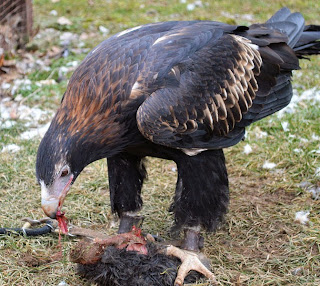At the World Bird Sanctuary, you will find over 200 animals, most of which are birds of
prey. From eagles to hawks to
owls, WBS is home to numerous different species of raptors. Keeping birds in captivity poses a few
challenges that WBS staff and volunteers must work through every day.
Every single one of World
Bird Sanctuary’s raptors gets fed a natural meat diet each day. Bald eagles may get fish, and Great
Horned Owls may get rats for example.
This food needs to be prepared on a daily basis for our 200+ animals.
Some birds get a little
extra care. For instance, older birds coping with arthritis get an arthritis
supplement on their food. Some
birds get extra calcium sprinkled on their meals for added benefit. Rehab patients may require daily
medications in their food. By
feeding frozen/thawed food, our birds (especially those with disabilities) do
not have any risk of injury during feeding as they might in the wild. They simply get their meals served up
to them on a silver platter.
The raptors at WBS are fed a natural
diet each day-Duncan the Wedge-tailed Eagle enjoys his lunch (photo: Paige Davis)
In the wild, birds of prey
are constantly scraping their talons on trees, rocks, and prey. In captivity, sometimes the birds need
a trim to help keep their talons from overgrowing. Just as our fingernails continuously grow, so do raptors’
talons. The staff at WBS must
monitor each bird and make sure their talons are well kept. It is like giving a manicure, but to
much sharper and more deadly “fingernails.”
Birds of prey have talons that grow continuously like our fingernails; they must be trimmed on a regular basis (photo: Paige Davis)
Just as the talons
continuously grow, so do birds’ beaks!
Birds’ beaks also need a trim (known in falconry as “coping”) once in a
while if they do not keep it worn down themselves. This can be an artistic task; shaping a bird’s beak requires
a good eye and a steady hand.
Luckily World Bird Sanctuary has a great team of people for such a task.
Pictured is a before and after of Ivory after a beak coping (photo: Paige Davis)
In addition to all of
these tasks, WBS staff and volunteers must also clean up after each animal and
maintain their exhibits. Birds do
not have a bladder to hold waste, which makes them lighter. It also makes for a lot of poop! And let me tell you, raptor poop is
like cement when it dries.
Caretakers often use a scraper to remove the waste before deep cleaning. It can be a very dirty job full of bird
poop, but it makes for some happy, healthy feathered
friends once the work is done.
Submitted by Paige Davis,
World Bird Sanctuary Naturalist







No comments:
Post a Comment